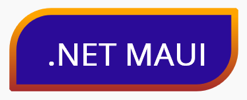Border
The .NET Multi-platform App UI (.NET MAUI) Border is a container control that draws a border, background, or both, around another control. A Border can only contain one child object. If you want to put a border around multiple objects, wrap them in a container object such as a layout. For more information about layouts, see Layouts.
Border defines the following properties:
Content, of typeIView, represents the content to display in the border. This property is theContentPropertyof the Border class, and therefore does not need to be explicitly set from XAML.Padding, of typeThickness, represents the distance between the border and its child element.StrokeShape, of typeIShape, describes the shape of the border. This property has a type converter applied to it that can convert a string to its equivalentIShape. Its default value is Rectangle. Therefore, a Border will be rectangular by default.Stroke, of type Brush, indicates the brush used to paint the border.StrokeThickness, of typedouble, indicates the width of the border. The default value of this property is 1.0.StrokeDashArray, of typeDoubleCollection, which represents a collection ofdoublevalues that indicate the pattern of dashes and gaps that make up the border.StrokeDashOffset, of typedouble, specifies the distance within the dash pattern where a dash begins. The default value of this property is 0.0.StrokeLineCap, of typePenLineCap, describes the shape at the start and end of its line. The default value of this property isPenLineCap.Flat.StrokeLineJoin, of typePenLineJoin, specifies the type of join that is used at the vertices of the stroke shape. The default value of this property isPenLineJoin.Miter.StrokeMiterLimit, of typedouble, specifies the limit on the ratio of the miter length to half the stroke thickness. The default value of this property is 10.0.
These properties are backed by BindableProperty objects, which means that they can be targets of data bindings, and styled.
Important
When creating a border using a shape, such as a Rectangle or Polygon, only closed shapes should be used. Therefore, open shapes such as Line are unsupported.
For more information about the properties that control the shape and stroke of the border, see Shapes.
Create a Border
To draw a border, create a Border object and set its properties to define its appearance. Then, set its child to the control to which the border should be added.
The following XAML example shows how to draw a border around a Label:
<Border Stroke="#C49B33"
StrokeThickness="4"
StrokeShape="RoundRectangle 40,0,0,40"
Background="#2B0B98"
Padding="16,8"
HorizontalOptions="Center">
<Label Text=".NET MAUI"
TextColor="White"
FontSize="18"
FontAttributes="Bold" />
</Border>
Alternatively, the StrokeShape property value can be specified using property tag syntax:
<Border Stroke="#C49B33"
StrokeThickness="4"
Background="#2B0B98"
Padding="16,8"
HorizontalOptions="Center">
<Border.StrokeShape>
<RoundRectangle CornerRadius="40,0,0,40" />
</Border.StrokeShape>
<Label Text=".NET MAUI"
TextColor="White"
FontSize="18"
FontAttributes="Bold" />
</Border>
The equivalent C# code is:
using Microsoft.Maui.Controls.Shapes;
using GradientStop = Microsoft.Maui.Controls.GradientStop;
...
Border border = new Border
{
Stroke = Color.FromArgb("#C49B33"),
Background = Color.FromArgb("#2B0B98"),
StrokeThickness = 4,
Padding = new Thickness(16, 8),
HorizontalOptions = LayoutOptions.Center,
StrokeShape = new RoundRectangle
{
CornerRadius = new CornerRadius(40, 0, 0, 40)
},
Content = new Label
{
Text = ".NET MAUI",
TextColor = Colors.White,
FontSize = 18,
FontAttributes = FontAttributes.Bold
}
};
In this example, a border with rounded top-left and bottom-right corners is drawn around a Label. The border shape is defined as a RoundRectangle object, whose CornerRadius property is set to a Thickness value that enables independent control of each corner of the rectangle:

Because the Stroke property is of type Brush, borders can also be drawn using gradients:
<Border StrokeThickness="4"
StrokeShape="RoundRectangle 40,0,0,40"
Background="#2B0B98"
Padding="16,8"
HorizontalOptions="Center">
<Border.Stroke>
<LinearGradientBrush EndPoint="0,1">
<GradientStop Color="Orange"
Offset="0.1" />
<GradientStop Color="Brown"
Offset="1.0" />
</LinearGradientBrush>
</Border.Stroke>
<Label Text=".NET MAUI"
TextColor="White"
FontSize="18"
FontAttributes="Bold" />
</Border>
The equivalent C# code is:
using Microsoft.Maui.Controls.Shapes;
using GradientStop = Microsoft.Maui.Controls.GradientStop;
...
Border gradientBorder = new Border
{
StrokeThickness = 4,
Background = Color.FromArgb("#2B0B98"),
Padding = new Thickness(16, 8),
HorizontalOptions = LayoutOptions.Center,
StrokeShape = new RoundRectangle
{
CornerRadius = new CornerRadius(40, 0, 0, 40)
},
Stroke = new LinearGradientBrush
{
EndPoint = new Point(0, 1),
GradientStops = new GradientStopCollection
{
new GradientStop { Color = Colors.Orange, Offset = 0.1f },
new GradientStop { Color = Colors.Brown, Offset = 1.0f }
},
},
Content = new Label
{
Text = ".NET MAUI",
TextColor = Colors.White,
FontSize = 18,
FontAttributes = FontAttributes.Bold
}
};
In this example, a border that uses a linear gradient is drawn around a Label:

Define the border shape with a string
In XAML, the value of the StrokeShape property can be defined using property-tag syntax, or as a string. Valid string values for the StrokeShape property are:
EllipseLine, followed by one or two x- and y-coordinate pairs. For example,Line 10 20draws a line from (10,20) to (0,0), andLine 10 20, 100 120draws a line from (10,20) to (100,120).Path, followed by path markup syntax data. For example,Path M 10,100 L 100,100 100,50Zwill draw a triangular border. For more information about path markup syntax, see Path markup syntax.Polygon, followed by a collection of x- and y-coordinate pairs. For example,Polygon 40 10, 70 80, 10 50.Polyline, followed by a collection x- and y-coordinate pairs. For example,Polyline 0,0 10,30 15,0 18,60 23,30 35,30 40,0 43,60 48,30 100,30.RectangleRoundRectangle, optionally followed by a corner radius. For example,RoundRectangle 40orRoundRectangle 40,0,0,40.
Important
While Line is a valid string value for the StrokeShape property, its use is not supported.
String-based x- and y-coordinate pairs can be delimited by a single comma and/or one or more spaces. For example, "40,10 70,80" and "40 10, 70 80" are both valid. Coordinate pairs will be converted to Point objects that define X and Y properties, of type double.
